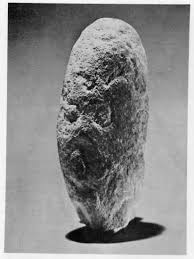Prehistory of Afghanistan
12 November 2010
Early humans in Afghanistan primarily settled along river terraces and in caves and rock shelters. The numerous stone tools scattered across the landscape serve as evidence of this early life, and archaeological excavations continue to uncover details about the region's ancient past.
Lower Paleolithic
The discovery of Lower Paleolithic tools, dating over 100,000 years ago, east of the brackish lake Dasht-i-Nawur, west of Ghazni, marked a significant finding (L. Dupree, 1974). These tools, mostly made from quartzite, include large flake cores, cleavers, side scrapers, choppers, adzes, hand axes, and proto-hand axes—making them the earliest Lower Paleolithic tools identified in Afghanistan.
In 1966, a team of American archaeologists began excavations at the Darra-i-Kur rock shelter, near Baba Darwesh in Badakhshan, seeking evidence of the migration of Neanderthal-like populations across Eurasia. There, they unearthed hundreds of classic Middle Paleolithic stone tools, dating to around 50,000 years ago. This represented the first scientifically documented Middle Paleolithic tools in Afghanistan (L. Dupree, director).
The team continued their search in 1969, moving west to Gurziwan near Maimana, where additional Middle Paleolithic tools were found, including types that resemble those discovered at Darra-i-Kur. These findings may suggest even older tool types than those from Darra-i-Kur. The tools found north of Dasht-i-Nawur in 1974 included Levallois flakes, scrapers, points, and possible burins, offering further insight into early human toolmaking.
Middle Paleolithic and Neanderthal Man
The tools found at Darra-i-Kur are typically associated with Neanderthal Man, with skeletons discovered in similar contexts, such as at Teshik Tash in Uzbekistan. However, at Darra-i-Kur, a prominent temporal bone was identified with features both modern and Neanderthaloid, suggesting that the area may have been a pivotal site in the evolution of early humans. This could mean that modern Homo sapiens, or at least a variety of early humans, might have developed in northern Afghanistan, potentially reshaping our understanding of human evolution.
Upper Paleolithic
The Upper Paleolithic period, dating from around 34,000 to 12,000 years ago, saw the development of more sophisticated stone tools. One of the earliest excavated Upper Paleolithic sites in Afghanistan was Kara Kamar, a rock shelter 23 km (14 miles) north of Samangan, which produced tools dating back to approximately 30,000 B.C. (C. Coon, 1954).
In the Balkh region, further excavations by American archaeologists in the 1960s and 1970s uncovered over 20,000 tools from rock shelters beside the Balkh River, dating to between 20,000 and 15,000 years ago. These tools, renowned for their craftsmanship, led one archaeologist to call the toolmakers "the Michelangelos of the Upper Paleolithic." Among these finds was a small limestone pebble carved with the face of a human, a rare early representation of human figures.
Mesolithic and Neolithic
In the Mesolithic period, approximately 10,000 years ago, Russian archaeologists discovered high-quality microlithic tools in the sand dunes south of the Amu Darya. These tools marked the transition to more complex forms of technology, with geometric shapes and new materials becoming prevalent.
By the Neolithic period, around 9,000 years ago, revolutionary advancements in agriculture and animal domestication occurred. The Neolithic site of Aq Kupruk, in northern Afghanistan, stands out as one of the early centers of plant and animal domestication, linking Afghanistan with the broader Neolithic developments of the Middle East and Central Asia. The evidence at Aq Kupruk supports the theory that the innovations of agriculture spread across the region from this area, extending through Anatolia and Greece.

Sculptured Head from Aq Kupruk, circa 20,000 BCE
Further evidence of Neolithic life can be found at Darra-i-Kur, where remains of domesticated goats were discovered, suggesting ritualistic practices and an early understanding of life and death. These burial sites point to the growing complexity of social and religious beliefs during this period.
Bronze Age
As humans advanced in agriculture, they began to establish permanent settlements. Around 5,000 B.C., early peasant farming villages emerged in Afghanistan, such as Deh Morasi Ghundai, southwest of Kandahar. This site, along with others in the region, provided essential insights into early Bronze Age life, where multi-roomed mud-brick structures were found, along with pottery, copper tools, and stone seals. Excavations in the Seistan region and at sites like Said Qala and Shamshir Ghar further reveal the Bronze Age cultural connections between Afghanistan, the Iranian Plateau, and Central Asia.
One notable find was the Khosh Tapa Hoard, uncovered in northern Afghanistan in 1966. This treasure, containing gold and silver goblets decorated with geometric designs and animal motifs, hints at long-distance trade, possibly linking Afghanistan with the ancient civilisations of Mesopotamia and the Indus Valley.
Late Bronze Age and Early Iron Age
The Bronze Age continued to flourish in northern Afghanistan, with the discovery of fine ceramic vessels, weapons, and jewelry at sites like Dashli and the Bronze Age mounds near Daulatabad. These finds offer a glimpse into the daily life and technological prowess of ancient Afghan civilisations.
As the cities of the Indus Valley, such as Mohenjo-daro and Harappa, grew, they developed complex economic systems that relied on trade and specialization. Evidence from Afghanistan indicates that trade networks stretched as far as Ur in Mesopotamia, with Afghanistan serving as a vital connector between the Middle East, Central Asia, and the Indus Valley.
Religious and Social Developments
Evidence of early religious practices has been uncovered at sites like Mundigak and Deh Morasi. These sites contain structures that may have served religious purposes, such as altars and temples, along with ritual objects like goat horns and copper seals. These findings highlight the spiritual and ceremonial importance of animals, particularly goats, in early Afghan societies.

Mother goddess figurines, right, from Mundigak, left,
from Deh Morasi Ghundai, 3rd Millennium EBC.
The Neolithic sites in northern Afghanistan also demonstrate early signs of settled life and ritualistic burial practices, laying the groundwork for the development of later civilisations in the region.
